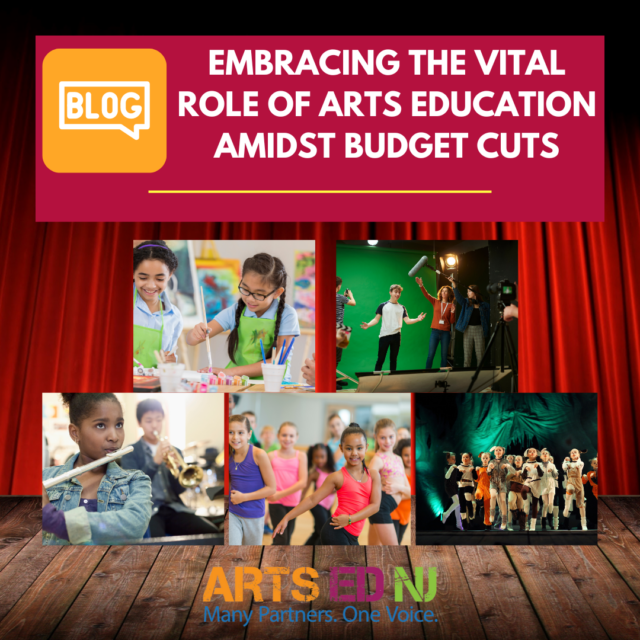 During times of school budget cuts, we know that communities face difficult decisions and that young people’s school experiences can be impacted in ways that can shift the trajectory of their lives. The losses are felt by the entire school community as they grapple with larger class sizes, cuts to teachers, counselors, and courses. Often Arts Education is the first area to be cut. Yet, in these challenging times, it’s crucial to know the facts about what students are promised by state policy and be prepared to articulate the profound impact of arts education on nurturing the holistic development of every child.
During times of school budget cuts, we know that communities face difficult decisions and that young people’s school experiences can be impacted in ways that can shift the trajectory of their lives. The losses are felt by the entire school community as they grapple with larger class sizes, cuts to teachers, counselors, and courses. Often Arts Education is the first area to be cut. Yet, in these challenging times, it’s crucial to know the facts about what students are promised by state policy and be prepared to articulate the profound impact of arts education on nurturing the holistic development of every child.
Arts Education is a Right
A well-rounded education encompasses all core academic subjects which includes the arts in NJ. Additionally, arts courses hold equal grade weight to other core content areas. Arts education plays a unique and vital role in nurturing the whole child by fostering creativity, critical thinking, and emotional expression. Arts programs (which includes 5 disciplines Dance, Theatre, Visual Arts, Music and Media Arts) positively impacts various aspects of student success, including academic achievement, graduation rates, and social-emotional well-being. As we navigate post-pandemic education challenges, arts education remains essential for fostering resilience, connection among students, preparing them to thrive in an increasingly complex and interconnected world.
The Power of Arts Education in Student Success:
The transformative impact of arts education on student success is undeniable. Research reveals that students who engage in arts programs are 4 times more likely to be recognized for academic achievement and 3 times more likely to be awarded for attendance. As renowned educator Sir Ken Robinson once remarked, “The arts, quite simply, nourish the soul.” According to a study by the National Endowment for the Arts, students involved in the arts are more likely to exhibit higher levels of empathy and emotional intelligence, contributing to their overall well-being.
Here are compelling reasons you can share with school board members, school administrative leaders, and family to explain WHY they should not cut arts education programming:
- Fostering Creativity and Innovation: The arts provide a unique platform for students to explore, experiment, and innovate. Whether through painting, music, theater, or dance, creative expression encourages critical thinking, problem-solving, and outside-the-box thinking. These skills are not only vital in artistic pursuits but also in various aspects of life and work, including STEM fields, entrepreneurship, and social activism.
- Cultivating Social Emotional Intelligence: Art has the power to evoke emotions, stimulate empathy, and foster self-awareness. Through engaging with artistic works and creating their own, students develop a deeper understanding of themselves and others. This social emotional intelligence is essential for building strong interpersonal relationships, navigating complex social dynamics, and promoting mental well-being. The impact of the arts on SEL competencies is so compelling that Arts Ed NJ has established the Center for Arts Education and Social Emotional Learning.
- Promoting Cultural Understanding and Appreciation: Arts education exposes students to diverse cultural perspectives, traditions, and histories. By studying works of art from different regions and time periods, students gain a deeper appreciation for the richness and complexity of human experience. This exposure fosters tolerance, respect, and an understanding of the interconnectedness of global communities.
- Building Confidence and Resilience: Participating in the arts provides students with opportunities to take risks, overcome challenges, and celebrate their achievements. Whether performing on stage, exhibiting their artwork, or composing music, students build confidence in their abilities and learn to persevere in the face of adversity. These experiences instill resilience and a growth mindset that are invaluable lifelong assets.
- Addressing Achievement Gaps and Inequities: Research has shown that access to arts education correlates with improved academic performance, attendance rates, and graduation rates, particularly for underserved and marginalized students. By cutting arts education programming, we risk exacerbating existing achievement gaps and perpetuating inequities in education. Investing in arts education ensures that all students have access to the transformative benefits of creative expression.
- Preparing Students for the Future of Work: In a rapidly changing and increasingly interconnected world, creativity and adaptability are essential skills for success. The jobs of the future will require individuals who can think critically, collaborate effectively, and communicate across diverse platforms. Arts education equips students with the skills and mindset needed to thrive in an ever-evolving workforce.
Share with legislators, local officials, school board members, parents/guardians, and community members, that cutting arts education programming undermines the holistic development of students and deprives them of invaluable opportunities for creativity, self-expression, and personal growth. Instead of viewing the arts as expendable luxuries, we must recognize them as essential components of a comprehensive education that prepares students to navigate the complexities of the 21st century and beyond. By investing in arts education, we invest in the future of New Jersey, nurturing the next generation of artists, innovators, leaders, and empathetic global citizens.
Arts Ed NJ has tools to support you. Please become an Arts Ed Champion and explore our Arts Ed Now and FOR ALL website that has step by step action plans and tools to help support your individualized needs. And please join us for our Champion meetings to get support from our staff and other like-minded advocates from across the state.

